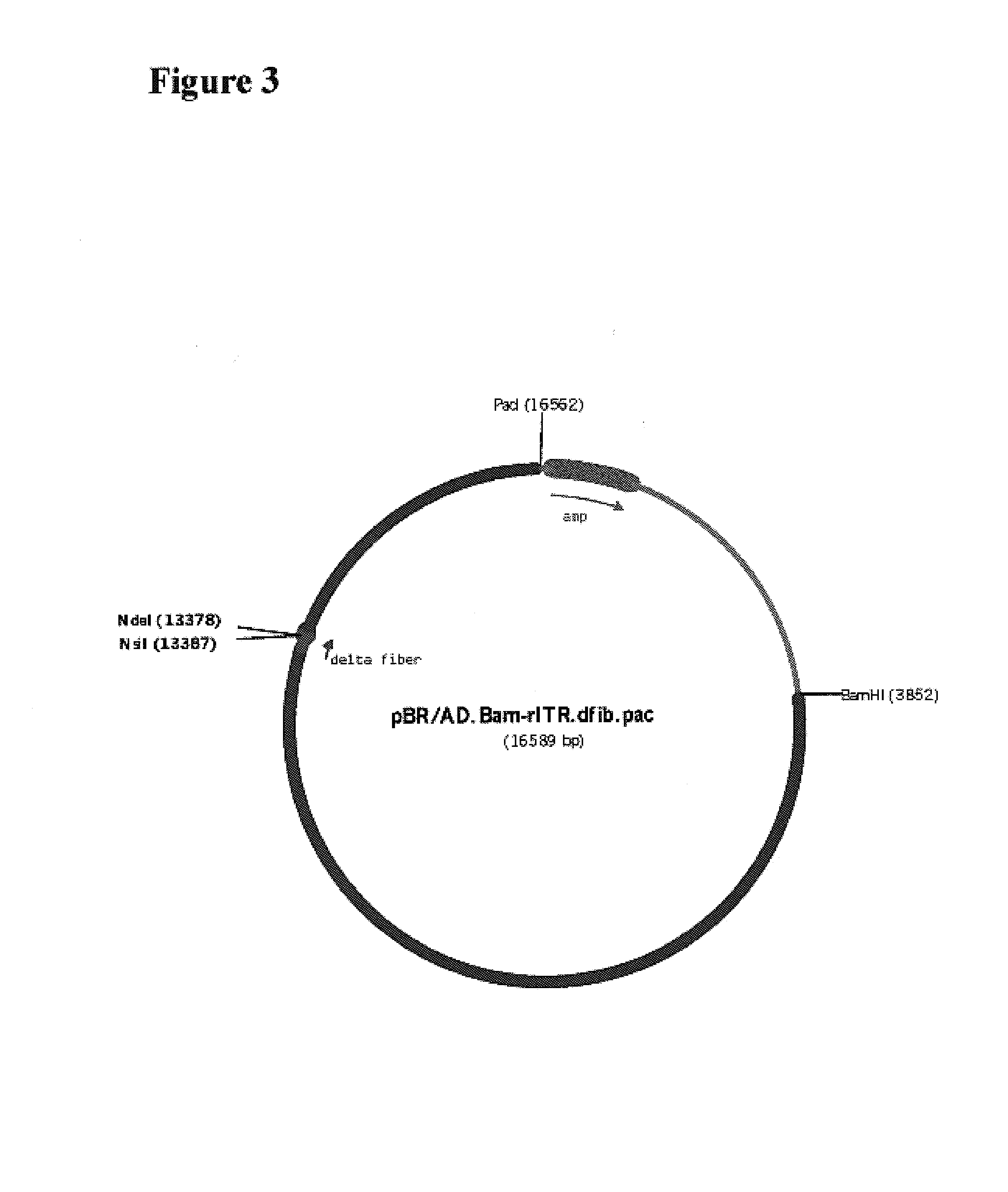Viral vectors having tissue tropism for T-lymphocytes, B- and mast cells
a technology of t-lymphocytes and mast cells, applied in the field of molecular genetics and medicine, can solve the problems of limiting the use of adenoviruses in specific applications, affecting the replication and other functions of adenoviruses, and reducing so as to improve the stability of the virus, improve the infection of a specific target cell, and reduce the infection of non-target cells
- Summary
- Abstract
- Description
- Claims
- Application Information
AI Technical Summary
Benefits of technology
Problems solved by technology
Method used
Image
Examples
example 1
Generation of Adenovirus Serotype 5 Based Viruses with Chimaeric Fiber Proteins.
[0241]The method described infra to generate recombinant adenoviruses by co-transfection of two, or more separate cloned adenovirus sequences. These cloned adenoviral sequences were subsequently used to remove specific adenovirus serotype 5 sequences in order to generate “template clones” which allow for the easy introduction of DNA sequences derived from other adenovirus serotypes. As an example of these template clones, the construction of plasmids enabling swapping of DNA encoding for fiber protein is given.
[0242]I-1 Generation of Adenovirus Template Clones Lacking DNA Encoding for Fiber
[0243]The fiber coding sequence of adenovirus serotype 5 is located between nucleotides 31042 and 32787. To remove the adenovirus serotype 5 DNA encoding fiber, we started with construct pBr / Ad.Bam-rITR (FIG. 1; ECACC deposit p97082122). First an NdeI site was removed from this construct. For this purpose, pBr322 plasm...
example 1a
An Ad5 / Fiber35 Chimeric Vector with Cell Type Specificity for Hemopoietic CD34+Lin− Stem Cells
[0262]Cells isolated from human bone marrow, umbilical cord blood, or mobilized peripheral blood carrying the flow cytometric phenotype of being positive for the CD34 antigen and negative for the early differentiation markers CD33, CD38, and CD71 (lin−) are commonly referred to as hemopoietic stem cells (HSC). Genetic modification of these cells is of major interest since all hemopoietic lineages are derived from these cells and therefore the HSC is a target cell for the treatment of many acquired or congenital human hemopoietic disorders. Examples of diseases that are possibly amenable for genetic modification of HSC include, but are not limited to, Hurlers disease, Hunter's disease, Sanfilippos disease, Morquios disease, Gaucher disease, Farbers disease, Niemann-Pick disease, Krabbe disease, Metachromatic Leucodistrophy, I-cell disease, severe immunodeficiency syndrome, Jak-3 deficiency, ...
example 2
Adenoviral Transduction of Human CD3+ T-lymphocytes with Crude and Purified Vector Preparations.
[0267]II-1: Isolation and Transduction of Primary T-Lymphocytes
[0268]To determine the transduction efficiency on human T-lymphocytes with chimaeric adenoviral vectors as described under Example 1, CD3+ cells were isolated from peripheral human blood. First the mononuclear cells were isolated from the blood by spinning the blood through a Vacutainer Cell Preparation Tube with Sodium Heparine (Becton Dickinson) for 30 minutes at 3700 rpm, low acceleration and no brake. The cells were washed once with PBS. Then the mononuclear cells were subjected to cell affinity chromatography using the Pan T-cell isolation kit and the Macs system of Miltenyi Biotec for isolation of CD3+ cells. The isolated cells were treated with an ammonium-chloride solution of 155 mM for a period of 2 minutes on ice to eliminate the remaining erythrocytes.
[0269]The percentage of CD3+ cells was determined by staining the...
PUM
| Property | Measurement | Unit |
|---|---|---|
| concentration | aaaaa | aaaaa |
| concentration | aaaaa | aaaaa |
| total volume | aaaaa | aaaaa |
Abstract
Description
Claims
Application Information
 Login to View More
Login to View More - R&D
- Intellectual Property
- Life Sciences
- Materials
- Tech Scout
- Unparalleled Data Quality
- Higher Quality Content
- 60% Fewer Hallucinations
Browse by: Latest US Patents, China's latest patents, Technical Efficacy Thesaurus, Application Domain, Technology Topic, Popular Technical Reports.
© 2025 PatSnap. All rights reserved.Legal|Privacy policy|Modern Slavery Act Transparency Statement|Sitemap|About US| Contact US: help@patsnap.com



